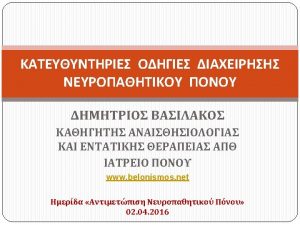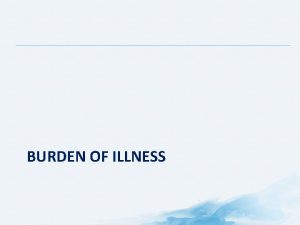SCOPE Empowering Family Physicians to Manage Chronic Pain

- Slides: 1

SCOPE: Empowering Family Physicians to Manage Chronic Pain F. Stuart Leeds 1 and Josephine F. Wilson 2 Departments of Family Medicine 1 and Community Health 2, Boonshoft School of Medicine, Wright State University, Dayton, Ohio Introduction Results • Chronic nonmalignant pain (CNMP) is one of the most common reasons for office visits to family physicians. • Because there is no defined scope of practice for CNMP, family physicians are reluctant to treat these patients – and often lack the training to do so • SCOPE is an evaluation and treatment protocol based on a defined scope of practice, and driven by evidence-based management principles • We hypothesized that SCOPE can be taught to FM residents in one or two brief, intensive clinical sessions; and that… • Once learned, SCOPE will measurably enhance a resident’s experience managing patients with chronic pain The Concentric Circles of Scope-of-Practice SCOPE – Scope-of-Care Oriented Pain Engagement The DESCRIBE Acronym • • SCOPE’s core is its scope-of-practice definition. Patients must: – Be reliable and reasonable – Be straightforward (medically and functionally) – Have exhausted non-opioid alternatives SCOPE’s principles of treatment include: – Preferential use of long-acting opioids – Best use of opioid-sparing adjuncts – “Universal precautions” – compliance testing for all Outer limits defined by the specialty itself Regional/local “cultural” standards (MALPRACTICE) Individual Training, Skill & Prerogatives SCOPE is aimed at expanding this inner circle Simplifying the Initial Evaluation of Patients with Chronic Pain • • Duration - must be chronic (>12 weeks) Etiology - one or more clear diagnoses to explain pain symptoms • • Story - narrative from onset to present Consultation – has been evaluated by appropriate specialist • • Red Flags? – by history, exam, labs, or PDMP Irreversible? - reversible causes of chronic pain addressed Basic– patient’s overall clinical picture and proposed regimen are not excessively complex • Summary of Results Exhausted all reasonable non-opioid alternatives • • Brief SCOPE training resulted in statistically-significant changes in pre/post questionnaire scores. – Sixteen of eighteen questions trended in the direction of improvement – Seven questions achieved individual statistical significance, including the key item: “I feel comfortable managing patients with chronic non-malignant pain. ” Subjective Experience and Perceived Competence improved significantly Total (overall “readiness”) scores also improved significantly Conclusion Methods • Twelve family medicine residents, all levels of training, studied over three years • Residents were trained to use SCOPE in two intensive clinical half-days with chronic pain patients • Eighteen-item Likert scale questionnaires regarding resident attitudes, beliefs and experiences regarding CNMP patients were completed before and after SCOPE training • Individual and total scores, as well as scores for the 4 question categories (Subjective Experience, Perceived Competence, Provider Beliefs, and Provider Behavior) were analyzed using paired T-tests. • SCOPE is a chronic pain management protocol built on an explicit definition of scope of practice for family physicians • SCOPE can be rapidly and effectively taught to family medicine residents in an office setting • Use of SCOPE results in a better physician experience with respect to chronic pain patients • SCOPE, therefore, has the potential to enhance access to care for patients with CNMP Reference: Leeds FS, Wilson JF (2014) A Novel Scope-of-Practice Based Paradigm for Empowering Family Physicians to Manage Chronic Nonmalignant Pain. J Family Med Community Health 1(4): 1023. PDF available, free of charge at: http: //www. jscimedcentral. com/Family. Medicine/familymedicine-1 -1023. pdf

